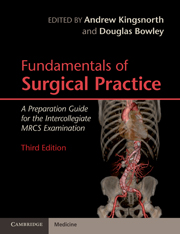Book contents
- Frontmatter
- Contents
- List of contributors
- Preface
- Section 1 Basic Sciences Relevant to Surgical Practice
- Section 2 Basic Surgical Skills
- Section 3 The Assessment and Management of the Surgical Patient
- Section 4 Perioperative Care of the Surgical Patient
- Section 5 Common Surgical Conditions
- 16 Assessment and early treatment of patients with trauma
- 17 Fundamentals of the central nervous system
- 18 Fundamentals of head and neck surgery
- 19 Fundamentals of thoracic surgery
- 20 Oesophago-gastric surgery
- 21 Fundamentals of hepatobiliary and pancreatic surgery
- 22 Fundamentals of endocrine surgery
- 23 Fundamentals of the breast
- 24 Lower gastrointestinal surgery
- 25 Fundamentals of the genitourinary system
- 26 Hernias
- 27 Fundamentals of vascular surgery
- 28 Fundamentals of orthopaedics
- 29 Fundamentals of plastic surgery
- 30 Surgical care of the paediatric patient
- 31 Fundamentals of organ transplantation
- Index
- References
17 - Fundamentals of the central nervous system
Published online by Cambridge University Press: 03 May 2011
- Frontmatter
- Contents
- List of contributors
- Preface
- Section 1 Basic Sciences Relevant to Surgical Practice
- Section 2 Basic Surgical Skills
- Section 3 The Assessment and Management of the Surgical Patient
- Section 4 Perioperative Care of the Surgical Patient
- Section 5 Common Surgical Conditions
- 16 Assessment and early treatment of patients with trauma
- 17 Fundamentals of the central nervous system
- 18 Fundamentals of head and neck surgery
- 19 Fundamentals of thoracic surgery
- 20 Oesophago-gastric surgery
- 21 Fundamentals of hepatobiliary and pancreatic surgery
- 22 Fundamentals of endocrine surgery
- 23 Fundamentals of the breast
- 24 Lower gastrointestinal surgery
- 25 Fundamentals of the genitourinary system
- 26 Hernias
- 27 Fundamentals of vascular surgery
- 28 Fundamentals of orthopaedics
- 29 Fundamentals of plastic surgery
- 30 Surgical care of the paediatric patient
- 31 Fundamentals of organ transplantation
- Index
- References
Summary
Anatomy
Scalp
The scalp is extremely vascular with blood supply coming from the external carotid arteries; anteriorly from the superficial temporal arteries which are branches of the maxillary arteries and posteriorly the occipital arteries. Since these vessels enter the scalp from the base upwards towards the vertex and since the supply is very good, provided the location of these supplying vessels is borne in mind, scalp incisions can be made almost anywhere with impunity without devascularizing the scalp. The layers of the scalp can be remembered by a mnemonic:
S skin
C subcutaneous tissue
A the aponeurosis (galea)
L loose areola tissue (the scalp is reflected back by dissecting this layer)
P pericranium (periosteum).
When suturing a scalp wound absorbable sutures are used to close the galea and then clips or sutures in the skin. As all the significant vessels lie within the subcutaneous tissue this two-layer closure tamponades the vessels and can control all scalp edge bleeding.
Skull
The skull is a complex series of connected bones. In the neonate the vault bones are only loosely attached at sutures and these join with cartilagenous fusion at 18 months. The skull reaches 90% of its adult size at approximately 7 years, and maximum size at puberty; the suture lines can be seen on skull radiographs throughout life but tend gradually to obliterate with advancing age. The skull varies in thickness in differing areas, being thickest in the parieto-occipital area and thinnest in the temporal area just above the mandibular articulation.
Information
- Type
- Chapter
- Information
- Fundamentals of Surgical PracticeA Preparation Guide for the Intercollegiate MRCS Examination, pp. 276 - 305Publisher: Cambridge University PressPrint publication year: 2011
